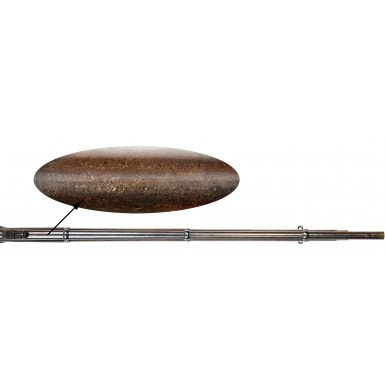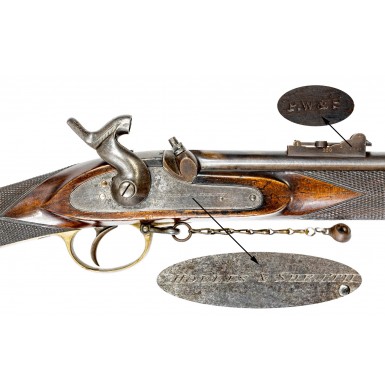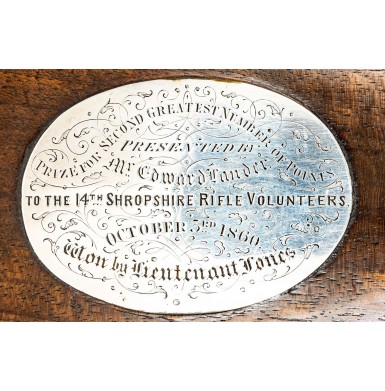Enfield Pattern 1853 Presentation Prize Volunteer Pattern Rifle Musket
- Product Code: FLA-3640-SOLD
- Availability: Out Of Stock
-
$1.00
During the mid-19th century a new phenomenon in British nationalism and concern for the defense of the country had manifested itself with the Volunteer Movement. The British military had become somewhat complacent during the long period of European peace in the post-Waterloo era, and had retained the rather outdated, flintlock ignition, India Pattern “Brown Bess” well into the percussion era. Even after the British military adopted the percussion ignition system, they retained the large caliber smoothbore musket as the standard line infantry weapon, while the rest of Europe was adopting rifled arms for general issue, and in the case of the Prussians, breechloading rifled arms.
The French revolution of 1848 had made Louis Napoleon Bonaparte, nephew of Emperor Napoleon Bonaparte I, the president of France. This substantially unsettled European relations. For the first time since Waterloo, the likelihood of a French war with England, as well as an invasion by the French, both seemed to be real possibilities. With hysteria ginned up by a burgeoning English press, a revived sense of nationalism and a somewhat unrealistic fear of a new war with France, many young Englishmen followed the advice of the pamphlets of the day and sought to join Volunteer Rifle organizations. These groups were based upon target shooting clubs that had existed previously, but instead of using specialized sporting rifles, the groups armed themselves with military pattern arms. Even though the guns were often enhanced and had special features that did not exactly conform to official military patterns, they were none the less “military pattern” arms. These organizations, much like pre-Civil War American militia companies usually armed, equipped and uniformed themselves as they saw best, buying what they could afford. The groups were sometimes sponsored communally, sometimes individually and sometimes at the expense of a wealthy citizen or group of citizens who underwrote the expense.
With the coming of the Crimean War and the alliance of France and England during that conflict the Volunteer movement lost some momentum, but not for long. By the latter part of the 1850s, with the war over and the possibility for French expansionism renewed, the Volunteers again took up their arms and fever spread throughout England.
With the adoption of the Pattern 1853 Enfield and its .577 (25 gauge) bore, the War Department started to set out some rules and regulations for these Volunteer Rifle groups, which were in fact budding militia companies. The first major rule was that all arms utilized would have to accept the standard government issued .577 cartridges. This still left a lot of latitude in the type of “military style” rifle that the volunteers acquired, but the guns were at least all to be of uniform caliber. While Whitworth, Kerr and Alexander Henry .451 small bore rifles are often lumped into the “Volunteer Rifle” category, their caliber excludes them from being true “Volunteer Rifles”, and rather they were military style target rifles that could only be used in “small bore” or “any rifle” matches. The wide variety of variation in the .577 military style rifles acquired by the volunteers was amazing, with some guns being almost exact military pattern arms and some only vaguely resembling them.
In an effort to standardize the arms of the volunteers, and because so many older Type I and Type II Pattern 1853 Enfields were available for refurbishment and issue to volunteer groups, by 1862 most volunteer organizations were being issued Pimlico refurbished Pattern 1853s dating back to the Crimean War and the Indian Mutiny. The variety of volunteer pattern arms that were available for sale in the gun shops of London and Birmingham circa 1861-1862 is well documented among the many patterns of rifle musket and particularly “short rifles” that were purchased by the Confederacy and exist today bearing Confederate inspection and inventory numbers. These guns range from checkered P1853 Enfields, checkered P1856 rifles with extended bayonet lugs and engraved furniture to brass mounted P-1856 Type II “Bar on Band” rifles, all of which outwardly resemble official British military pattern long arms, but do not truly conform to those patterns.
The interest in shooting and the shooting sports was not necessarily restricted to these volunteer companies, and the top shooters of the mid to late 19th century were in many ways the sports icons of the era. Huge shooting matches were held at Wimbledon in London, with the National Rifle Association of the United Kingdom inaugurating the Wimbledon Cup as the grand prize for the winning shooting team in 1866. In 1875, that prize was won by the American team and the cup was taken back to America where it resided at the National Rifle Association Creedmoor Rifle Range on Long Island, which is now Queen’s Village, Queens, New York. Today the cup is still awarded on an annual basis after the annual National Rifle and Pistol matches at Camp Perry. Numerous smaller matches were held in England and America, with a variety of prizes offered for the best team shooters as well as individual shooters. The modern descendants of these shooting competitions live on with the support of both the American NRA and the British NRA, with competitions like those hosted at Camp Perry, OH and by the North-South Skirmish Association in Virginia being direct descendants of the popularity of 19thcentury target shooting.
Offered here is a VERY GOOD example of a commercial production British Pattern 1853 Enfield Rifle Musket of the classic “Volunteer” pattern, complete with an engraved shooting award plaque in the butt. Like the standard military issued Pattern 1853 rifle muskets, this one has a 39” barrel and accepts a socket bayonet. It retains the standard brass furniture of a normal P1853, the typical 900 yard musket rear sight and the standard three-groove progressive depth rifling. Volunteer pattern guns were often enhanced cosmetically with engraved locks and furniture, as well as checkered stocks, often of walnut with fancy grain. Often, they also incorporated mechanical improvements like higher quality locks, which were regularly highly tuned and polished for a smooth action and light trigger pull. This example has one of those finely checkered walnut stocks.
This Shooting Prize Pattern 1853 Enfield Volunteer Rifle Musket is a classic example of this pattern of arm. The gun is a standard Pattern 1853 Rifle Musket that conforms to the usual P1853 specifications, but has been slightly enhanced with a higher level of fit and finish as well as with the checkered wrist and forend. The gun was clearly intended for commercial sale, rather than a government contract military arm and bears the usual Birmingham commercial proof marks on the left breech of the barrel, interspersed by a pair of 25 gauge marks, to indicate .577 caliber. Additionally, the lock is not marked with the usual British {CROWN} to the rear of the hammer or with a common “Tower & Date” mark forward of the hammer as would be expected on a commercial gun. Instead the lock is marked in a single line, forward of the hammer: HOLLIS & SHEATH. The firm of Hollis & Sheath was established in 1849 as a partnership between Isaac Hollis and Isaac Sheath. Hollis was descended from a long-time Birmingham gunmaking family and advertising from the post-1861 period referred to the firm originating in 1814, which was when a Richard & William Hollis (likey his father and uncle) went into business. The firm was located on Weaman Row from 1849-1850, moving to 49 Whittal Street in 1851 and finally to 5-11 Weaman Row in 1853, where they remained until the firm was reorganized as Isaac Hollis & Sons. The latter firm remained in business in Birmingham through the turn of the century, disappearing from the directories after 1900. In addition to manufacturing a wide variety of military and sporting arms from 1849-1861, Hollis & Sheath had the exclusive rights to produce Frederick Prince’s percussion breechloading arms under license. These rights were transferred to the London Armoury Company in 1861, after Hollis & Sheath reorganized. Isaac Sheath additionally held British Patent #996/1853 for a percussion revolver. Isaac Hollis would become of the three largest investors in the newly organized Birmingham Small Arms Company, LTD in 1861. This gun manufacturing consortium was established with 2,000 shares of stock with Hollis and Thomas Turner each owning 95 shares (4.75%), and only J.F. Swinburne owning more, 110 shares for 5.5%. No other investor owned as much of the company as these three men.
The barrel is also engraved in three lines, forward of the rear sight and behind the rear barrel band:
HOLLIS & SHEATH
MAKER’S TO HER MAJESTY’S
WAR DEPARTMENT
This marking is somewhat weak due to wear. The interior of the lock has the mating number 1 on primary parts, including the lock plate and hammer. The bottom of the barrel is marked by the Birmingham barrel making family CLIVE, but it is not clear which “Clive” made the barrel. The barrel is additionally stamped a variety of small maker and assembly marks. The barrel channel of the stock is stamped with two Hollis & Sheath worker’s marks, a H&S 47 and a H&S 19. The rear sight is marked P.W.&S, indicting that it was produced by the firm of Philip Webley & Son. A small German silver oval escutcheon is set into the lower wrist of the stock, behind the triggerguard and a large German silver presentation plaque is set into the obverse stock. The plaque is engraved in six lines and reads:
PRIZE FOR SECOND GREATEST NUMBER OF POINTS
PRESENTED BY
Mr. Edward d’Vander
TO THE 14TH SHROPSHIRE RIFLE VOLUNTEERS
OCTOBER 3RD 1860
Won by Lieutenant Jones
The Shropshire Rifle Volunteers were established in 1859 with some 18 companies being formed between 1859 and 1860. This was later reduced to 16 companies, with one being redesignated as an artillery company. Typical company strength was between 100 and 120 men. The 14th company was from the small village of Shifnal, a few miles outside of Shropshire. Shropshire is on the border of North Wales and is surrounded by Cheshire, Staffordshire, Herefordshire and Worcestershire. Shropshire is approximately 3 hours from London, an hour or so from Manchester and only 40 about minutes from Birmingham. The regiment was organized as two administrative battalions, with the 14th assigned to the 1stBattalion. In 1880, the two battalions were redesignated as the 1st and 2nd Shropshire Rifle Volunteer Corps and in 1888 were redesignated as the 1st and 2nd Volunteer Battalions, King’s Shropshire Light Infantry. The regiment saw its first real combat in South Africa during the Boer War circa 1900-1902. In 1908, with the complete reorganization of the of the Volunteer forces and the formation of the “Territorial Force” as a sort of British “national guard”, the two battalions of the Shropshire Light Infantry were redesignated as the 4th Territorial Battalion, King’s Shropshire Light Infantry. During the Great War, the 4th Territorial Battalion KSLI were initially deployed to the Far East in August of 1914 and were later sent to the Western Front, where they served from 1917 to 1918. While my research could not locate “Lieutenant Jones”, further research might prove fruitful and reveal some mid-19th century military service. Additionally, further research about the benefactor who provided the gun, Mr. Edward d’Vander might prove interesting as well.
As noted, the rifle musket is in about VERY GOOD condition. The rifle appears original and correct in all respects, with the exception of a replaced ramrod. The metal surfaces of the gun have a moderately oxidized mottled plum brown patina with scattered surface oxidation, light to moderate pinpricking, and some light potting present. There are some light traces of an old, reblued finish present in the protected areas of the gun, with the bands retaining much of that old added blue. The bore of the rifle rates about FINE. The rifling remains strong and crisp along the entire length of the bore. The bore is almost entirely mirror bright with some lightly scattered oxidation and minor frosting in the grooves. The lock of the gun is mechanically excellent and functions well on all positions, with a strong mainspring and crisp engagement between the sear and tumbler, as would be expected on a competition quality rifle. The trigger is also very smooth and crisp; much nicer than typically encountered on an Enfield rifle musket. The lock retains only minute traces of its casehardened finish and has a mottled and oxidized patina of browns and grays. The gun retains its correct and original long-range rear sight that is graduated to 900 yards, which is correct for this period of production. The original combination front sight and socket bayonet lug is in place near the muzzle on the top of the barrel as well. Both sling swivels are in place, although the upper one may be an old replacement. An original snap cap is even in place on its brass chain, secured to the stock with the original iron split ring. These metal and leather “nipple protectors” allowed the solider to “dry fire” his weapon without damaging the cone (nipple). These little accessories were included with every rifle and musket but are rarely found with the guns today. This one is in good condition, with most of the leather padding worn away. The brass furniture has an attractive, uncleaned dull bronze patina. The stock of the rifle is in about FINE condition. The stock is full length and free of any breaks, cracks or repairs. The stock retains very crisp edges and shows no indication of having been sanded. The checkering remains quite crisp as well, with only some light wear. As would be expected the stock shows some scattered bumps, dings and minor impact marks, all likely the result of actual use.
Overall this is a very nice, solid and attractive example of a British Pattern 1853 Presentation Prize Volunteer Enfield Rifle Musket. The rifle is identified to its winner, and more research might be able to determine if Lieutenant Jones saw any additional military service prior to joining the Shropshire Rifle Volunteers or was involved in any of their forays later in their history. This is a lovely gun with a fine lock and bore and would likely still shoot quite well at the range today. It would be a nice addition to any collection of Enfield Rifle Muskets or to a collection of 19th century English presentation, prize and target rifles.
SOLD
Tags: Enfield, Pattern, 1853, Presentation, Prize, Volunteer, Pattern, Rifle, Musket















